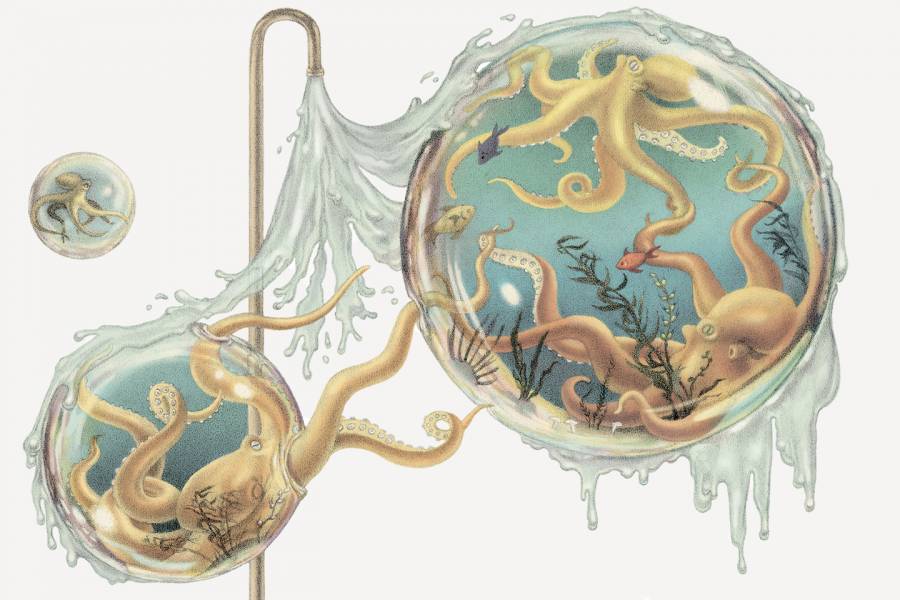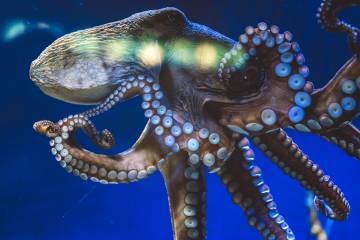Five hundred million years of evolution separates humans from the seafloor-scuttling octopus, an invertebrate that stores most of its brain cells in its eight arms. But over the past few years, marine scientists have been discovering some surprising behavior from octopuses: stealing fish from neighboring tanks and fishermen, identifying "nice" and "mean" keepers, and turning off lights by squirting water at overhead bulbs to short out the power supply.
So when Gül Dölen, a Johns Hopkins assistant professor of neuroscience, wanted to test some ideas about how neural circuits govern social behavior, she reached for an octopus—or rather seven of them—from the Marine Biological Laboratory in Woods Hole, Massachusetts.
Context
Dölen and her colleagues are interested in the biological basis of social behavior, as well as how the mood-altering drug MDMA (aka Ecstasy) works to release serotonin, a hormone that is known mostly for its influences on moods but that also plays an important role in regulating sleep patterns and digestion.
"I've always been interested in evolution, and looking at the octopus offered a really neat opportunity to examine the evolutionary mechanisms of social behaviors," Dölen says. "Their brains are completely different [from humans'], but they have some of the same molecular machinery." Dölen wanted to know if she could induce social behavior in a normally antisocial animal.
Experiment
The test animal—a male California two-spot octopus—was put in a seawater solution containing dissolved MDMA for 10 minutes. The team then released the octopus for 30 minutes into the middle chamber of a three-compartment fish tank. On one side was a Star Wars figurine within an upside-down flower pot with holes. In the third chamber was a second octopus, which had not been dosed with MDMA, underneath a similar structure. "We didn't want to stick them into a tank together and watch because they might hurt each other," Dölen says. "With the plastic pot, they could see each other and touch each other but not kill each other." Normally the two octopuses would have kept their distance and instead played with the toy. But in three of four tests, the MDMA-dosed male octopuses ignored the figurine and tried to touch the second male animal. When a female octopus was put underneath the pot, however, the MDMA-dosed octopus retreated to his tank. Female octopuses are larger and more aggressive toward males in the wild, indicating that the mood-altering MDMA did not override caution.
The researchers, who published their study in Current Biology, were also able to find the octopus gene that makes a protein to transport MDMA, which causes the body to release large amounts of serotonin. It turns out that humans and octopuses have a 100 percent match for the parts of the molecule responsible for this protein.
Conclusion
Dölen was surprised to find male octopuses acting cuddly under the influence of MDMA. "We honestly didn't think it was going to work," she says, "because they are so different from us, and because [MDMA] is a synthetic compound" that does not exist in nature.
The fact that the MDMA binding site is the same in humans and octopuses indicates that the serotonin transporter gene has been around for at least 500 million years, before mammals developed a complex brain. Because the octopus doesn't have a cerebral cortex or nucleus accumbens—parts of the brain associated with social functions in mammals—Dölen says the mechanism shared by octopus and human brains is molecular.
Next Steps
Medical researchers are using MDMA to treat symptoms of post-traumatic stress disorder. Unlocking how the drug works on brain cells and synapses in the octopus may lead to better medical therapies for humans, Dölen says.
The researchers next want to observe the results of the experiment when conducted with equal numbers of male and female octopuses. They also want to add Prozac to the tank, which inhibits the serotonin transporter.
One final note: After the experiment, the MDMA-dosed animals returned to normal and were put back in their tanks in Woods Hole.
Posted in Science+Technology
Tagged biology, neuroscience, psychedelics









